Abstract
Chronic inflammatory myositis similar to human polymyositis occurs in mice after infection with a strain of Coxsackievirus B 1 (CVB 1). To investigate the role of T cells in the pathogenesis of this disorder, we compared disease expression in T cell-deficient athymic nude (nu/nu) mice and heterozygotes (nu/+) with normal T cell function. Acute infectious myositis occurred in nu/nu and nu/+ mice. Chronic (greater than 21 d postinfection) weakness and myositis, however, developed only in nu/+. Resistance to disease in nu/nu mice was not explained by insusceptibility to infection; the amount of virus lethal for 50% of mice and virus replication were comparable in both groups. Additionally, anti-CVB 1 antibody production was similar in both groups. Reconstitution of infected nu/nu mice with spleen cells from normal mice resulted in disease. These results demonstrate that chronic weakness after infection with this virus is not simply a sequela of acute myonecrosis and suggest that T cells play a pivotal role in the pathogenesis of chronic myositis.
Full text
PDF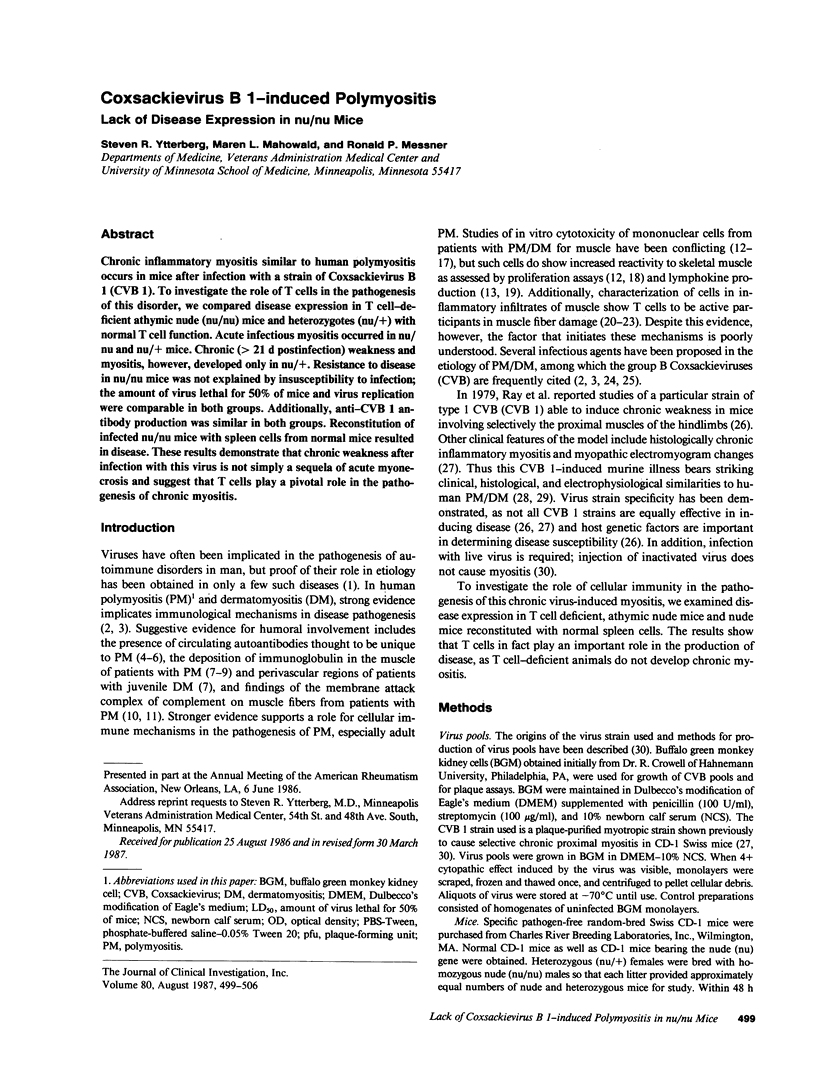
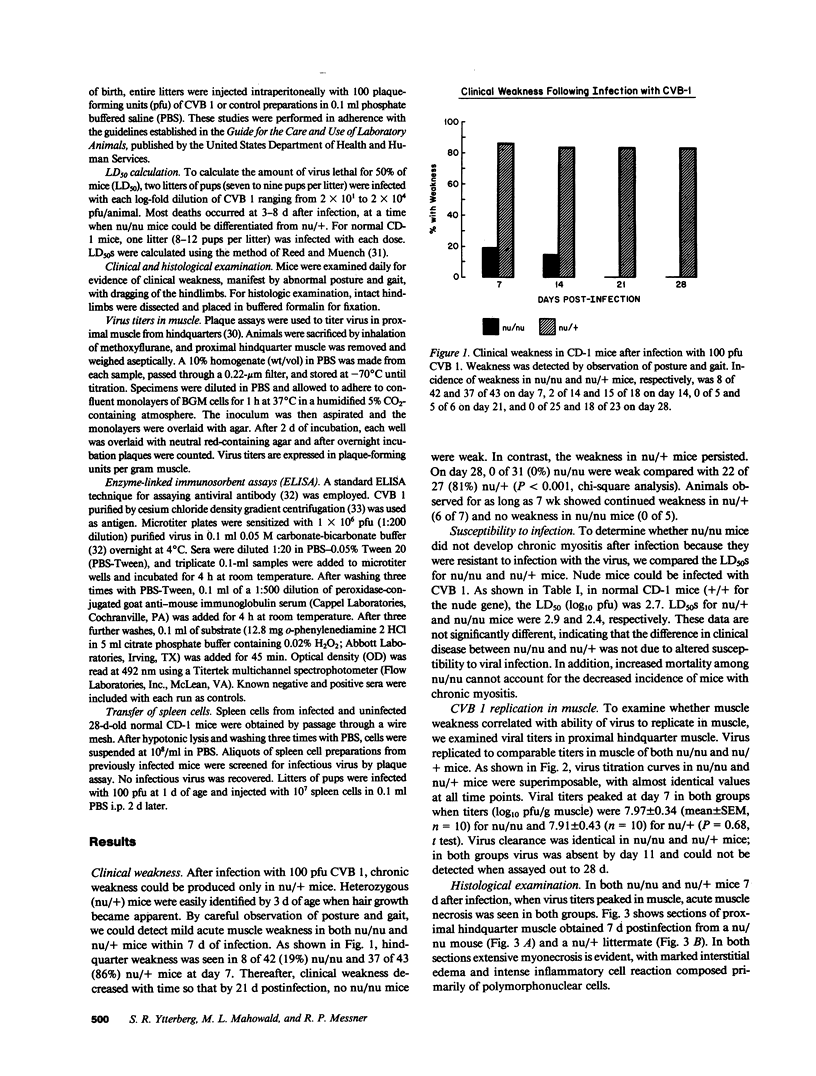
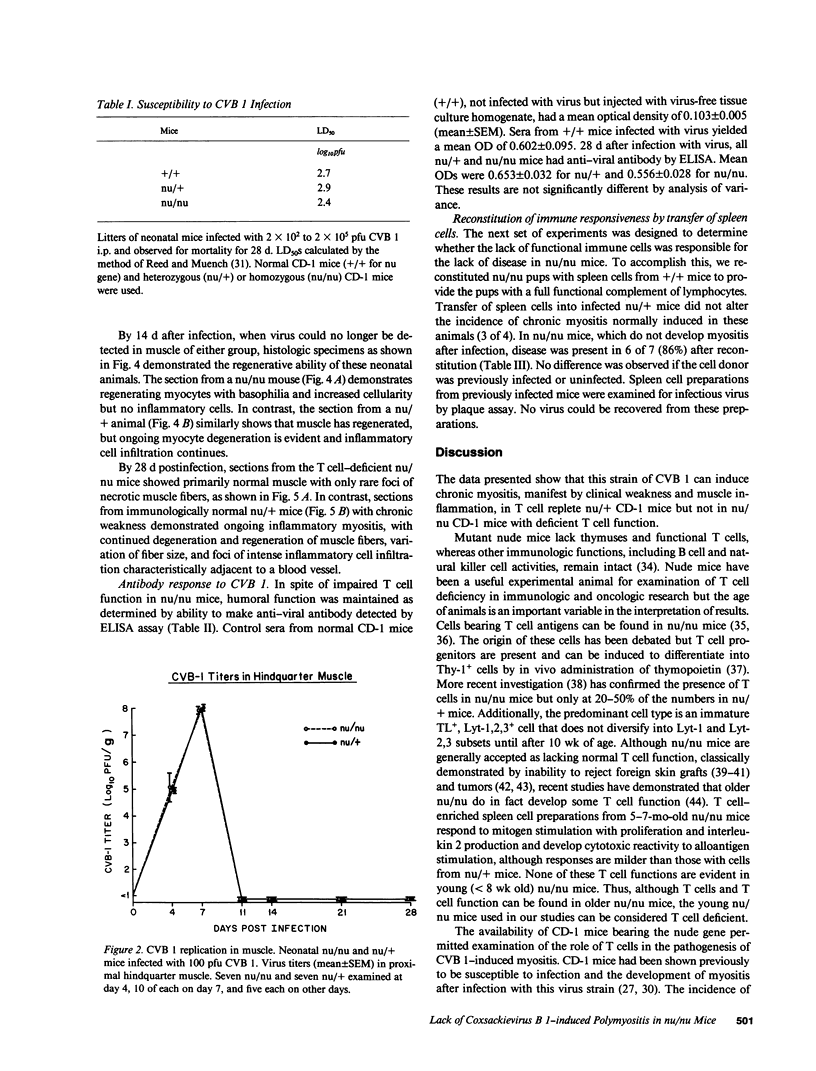
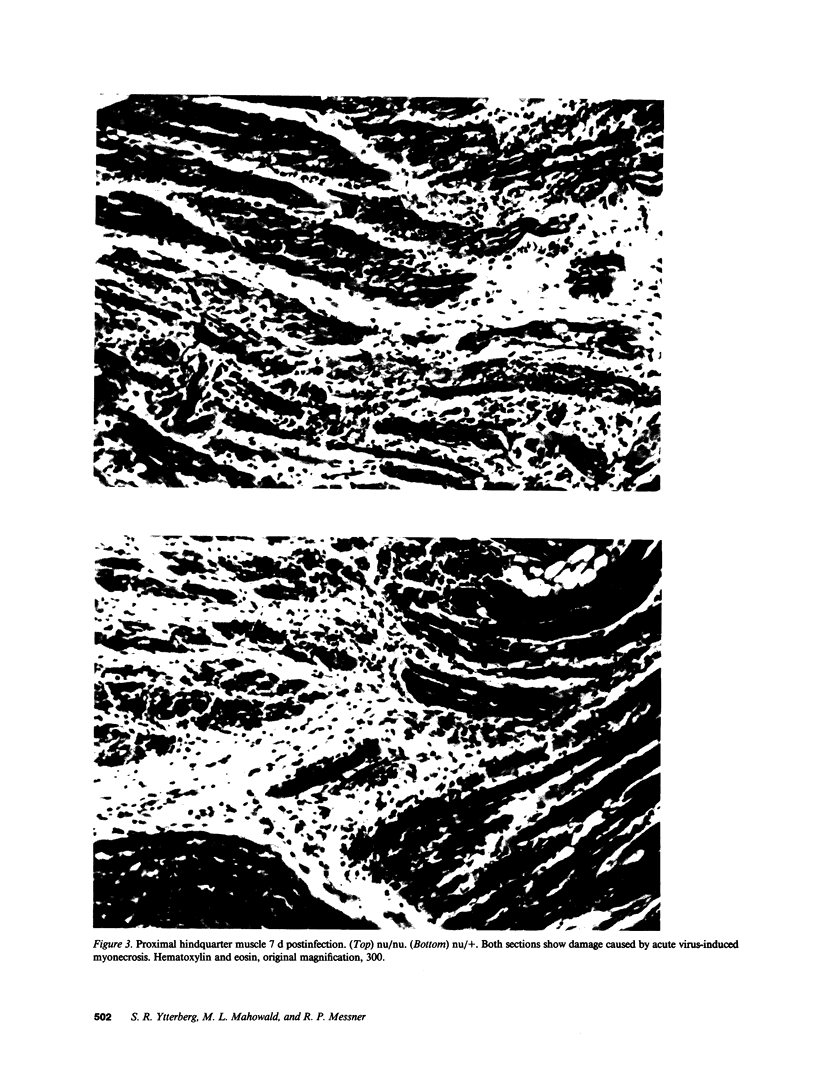
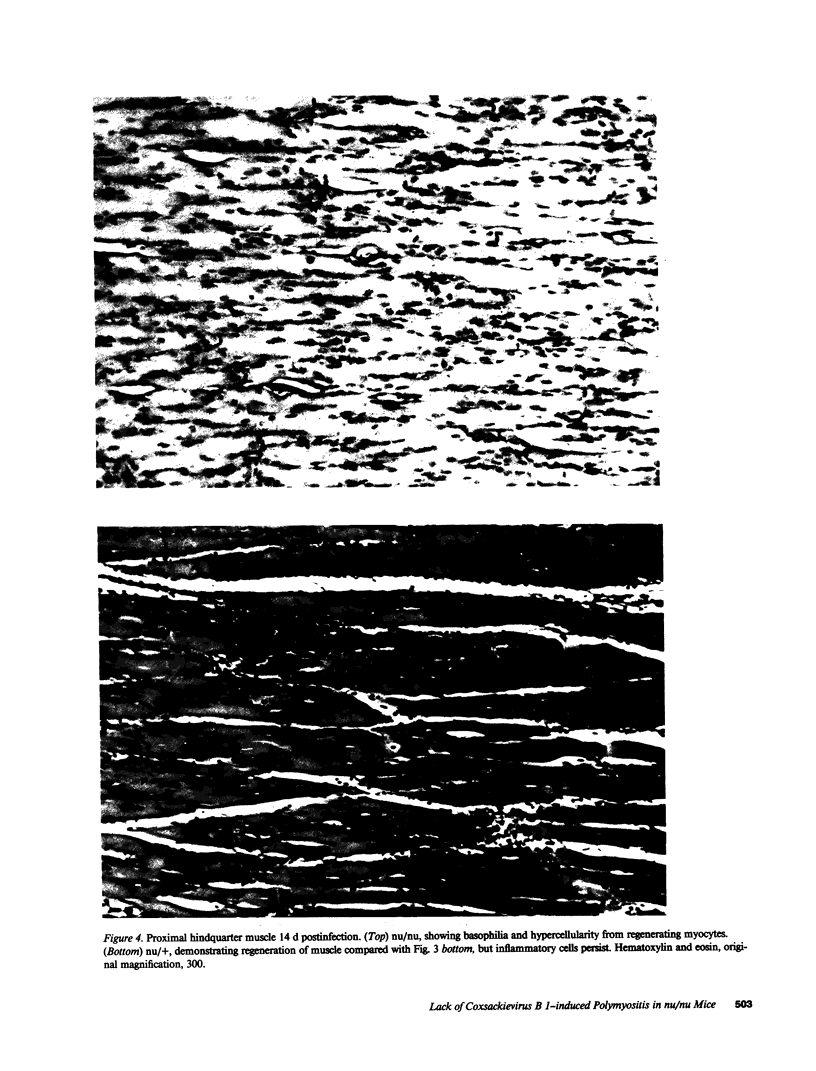
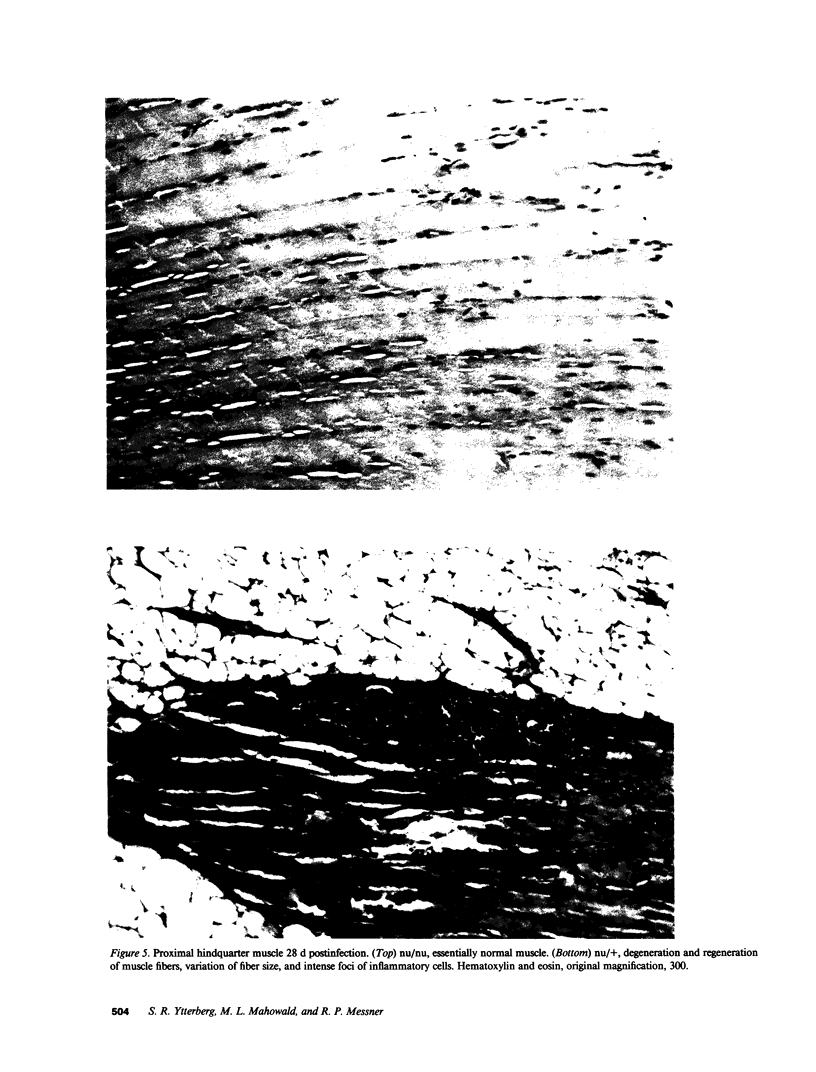
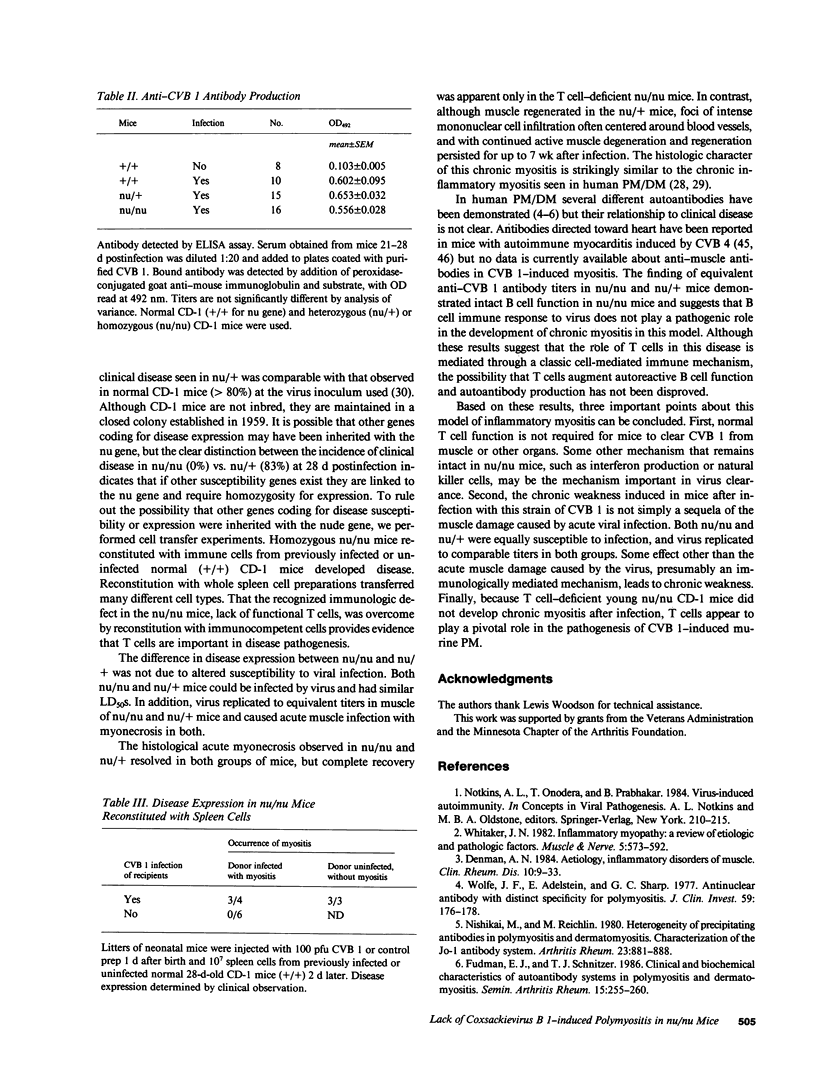
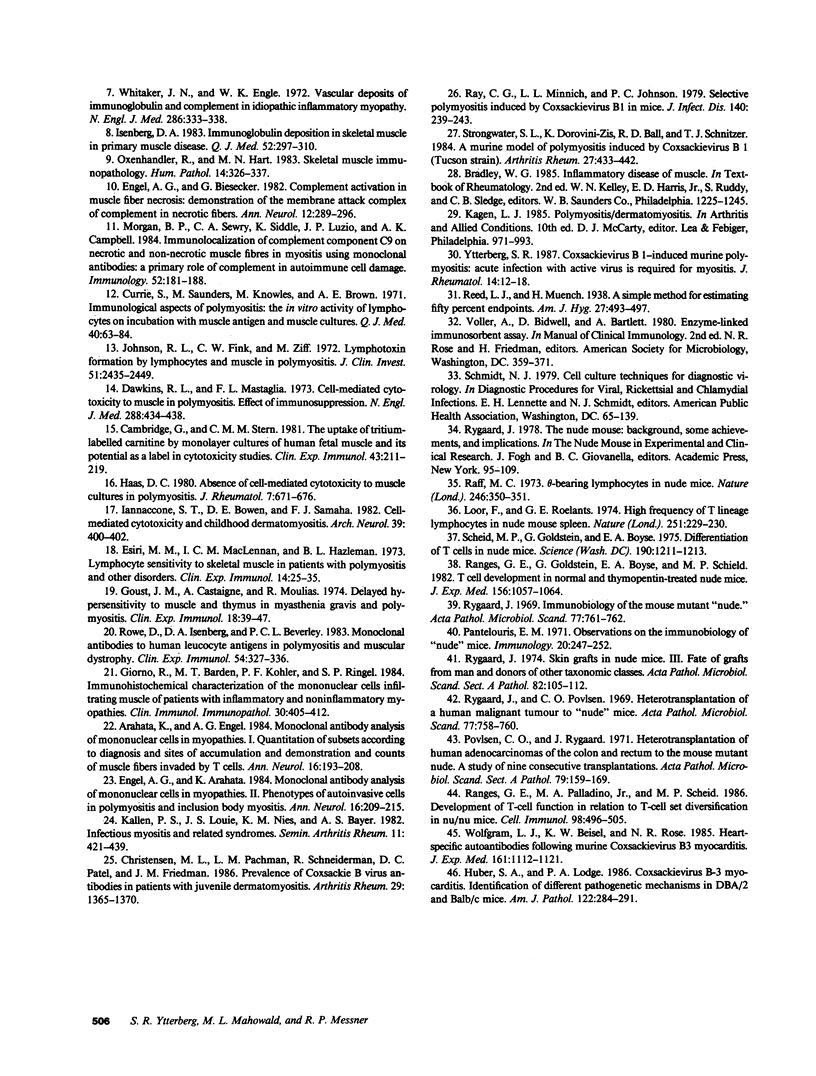
Images in this article
Selected References
These references are in PubMed. This may not be the complete list of references from this article.
- Arahata K., Engel A. G. Monoclonal antibody analysis of mononuclear cells in myopathies. I: Quantitation of subsets according to diagnosis and sites of accumulation and demonstration and counts of muscle fibers invaded by T cells. Ann Neurol. 1984 Aug;16(2):193–208. doi: 10.1002/ana.410160206. [DOI] [PubMed] [Google Scholar]
- Cambridge G., Stern C. M. The uptake of tritium-labelled carnitine by monolayer cultures of human fetal muscle and its potential as a label in cytotoxicity studies. Clin Exp Immunol. 1981 Apr;44(1):211–219. [PMC free article] [PubMed] [Google Scholar]
- Christensen M. L., Pachman L. M., Schneiderman R., Patel D. C., Friedman J. M. Prevalence of Coxsackie B virus antibodies in patients with juvenile dermatomyositis. Arthritis Rheum. 1986 Nov;29(11):1365–1370. doi: 10.1002/art.1780291109. [DOI] [PubMed] [Google Scholar]
- Currie S., Saunders M., Knowles M., Brown A. E. Immunological aspects of polymyositis. The in vitro activity of lymphocytes on incubation with muscle antigen and with muscle cultures. Q J Med. 1971 Jan;40(157):63–84. [PubMed] [Google Scholar]
- Dawkins R. L., Mastaglia F. L. Cell-mediated cytotoxicity to muscle in polymyositis. Effect of immunosuppression. N Engl J Med. 1973 Mar 1;288(9):434–438. doi: 10.1056/NEJM197303012880903. [DOI] [PubMed] [Google Scholar]
- Denman A. M. Inflammatory disorders of muscle. Aetiology. Clin Rheum Dis. 1984 Apr;10(1):9–33. [PubMed] [Google Scholar]
- Engel A. G., Arahata K. Monoclonal antibody analysis of mononuclear cells in myopathies. II: Phenotypes of autoinvasive cells in polymyositis and inclusion body myositis. Ann Neurol. 1984 Aug;16(2):209–215. doi: 10.1002/ana.410160207. [DOI] [PubMed] [Google Scholar]
- Engel A. G., Biesecker G. Complement activation in muscle fiber necrosis: demonstration of the membrane attack complex of complement in necrotic fibers. Ann Neurol. 1982 Sep;12(3):289–296. doi: 10.1002/ana.410120314. [DOI] [PubMed] [Google Scholar]
- Esiri M. M., MacLennan I. C., Hazleman B. L. Lymphocyte sensitivity to skeletal muscle in patients with polymyositis and other disorders. Clin Exp Immunol. 1973 May;14(1):25–35. [PMC free article] [PubMed] [Google Scholar]
- Fudman E. J., Schnitzer T. J. Clinical and biochemical characteristics of autoantibody systems in polymyositis and dermatomyositis. Semin Arthritis Rheum. 1986 May;15(4):255–260. doi: 10.1016/0049-0172(86)90021-1. [DOI] [PubMed] [Google Scholar]
- Giorno R., Barden M. T., Kohler P. F., Ringel S. P. Immunohistochemical characterization of the mononuclear cells infiltrating muscle of patients with inflammatory and noninflammatory myopathies. Clin Immunol Immunopathol. 1984 Mar;30(3):405–412. doi: 10.1016/0090-1229(84)90026-6. [DOI] [PubMed] [Google Scholar]
- Goust J. M., Castaigne A., Moulias R. Delayed hypersensitivity to muscle and thymus in myasthenia gravis and polymyositis. Clin Exp Immunol. 1974 Sep;18(1):39–47. [PMC free article] [PubMed] [Google Scholar]
- Haas D. C. Absence of cell-mediated cytotoxicity to muscle cultures in polymyositis. J Rheumatol. 1980 Sep-Oct;7(5):671–676. [PubMed] [Google Scholar]
- Huber S. A., Lodge P. A. Coxsackievirus B-3 myocarditis. Identification of different pathogenic mechanisms in DBA/2 and Balb/c mice. Am J Pathol. 1986 Feb;122(2):284–291. [PMC free article] [PubMed] [Google Scholar]
- Iannaccone S. T., Bowen D. E., Samaha F. J. Cell-mediated cytotoxicity and childhood dermatomyositis. Arch Neurol. 1982 Jul;39(7):400–402. doi: 10.1001/archneur.1982.00510190018005. [DOI] [PubMed] [Google Scholar]
- Isenberg D. A. Immunoglobulin deposition in skeletal muscle in primary muscle diseases. Q J Med. 1983 Summer;52(207):297–310. [PubMed] [Google Scholar]
- Johnson R. L., Fink C. W., Ziff M. Lymphotoxin formation by lymphocytes and muscle in polymyositis. J Clin Invest. 1972 Sep;51(9):2435–2449. doi: 10.1172/JCI107057. [DOI] [PMC free article] [PubMed] [Google Scholar]
- Kallen P. S., Louie J. S., Nies K. M., Bayer A. S. Infections myositis and related syndromes. Semin Arthritis Rheum. 1982 May;11(4):421–439. doi: 10.1016/0049-0172(82)90029-4. [DOI] [PubMed] [Google Scholar]
- Loor F., Roelants G. E. High frequency of T lineage lymphocytes in nude mouse spleen. Nature. 1974 Sep 20;251(5472):229–230. doi: 10.1038/251229a0. [DOI] [PubMed] [Google Scholar]
- Morgan B. P., Sewry C. A., Siddle K., Luzio J. P., Campbell A. K. Immunolocalization of complement component C9 on necrotic and non-necrotic muscle fibres in myositis using monoclonal antibodies: a primary role of complement in autoimmune cell damage. Immunology. 1984 May;52(1):181–188. [PMC free article] [PubMed] [Google Scholar]
- Nishikai M., Reichlin M. Heterogeneity of precipitating antibodies in polymyositis and dermatomyositis. Characterization of the Jo-1 antibody system. Arthritis Rheum. 1980 Aug;23(8):881–888. doi: 10.1002/art.1780230802. [DOI] [PubMed] [Google Scholar]
- Oxenhandler R., Hart M. N. Skeletal muscle immunopathology. Hum Pathol. 1983 Apr;14(4):326–337. doi: 10.1016/s0046-8177(83)80118-x. [DOI] [PubMed] [Google Scholar]
- Pantelouris E. M. Observations on the immunobiology of 'nude' mice. Immunology. 1971 Feb;20(2):247–252. [PMC free article] [PubMed] [Google Scholar]
- Povlsen C. O., Rygaard J. Heterotransplantation of human adenocarcinomas of the colon and rectum to the mouse mutant Nude. A study of nine consecutive transplantations. Acta Pathol Microbiol Scand A. 1971;79(2):159–169. doi: 10.1111/j.1699-0463.1971.tb03324.x. [DOI] [PubMed] [Google Scholar]
- Raff M. C. Theta-bearing lymphocytes in nude mice. Nature. 1973 Dec 7;246(5432):350–351. doi: 10.1038/246350a0. [DOI] [PubMed] [Google Scholar]
- Ranges G. E., Goldstein G., Boyse E. A., Schield M. P. T cell development in normal and thymopentin-treated nude mice. J Exp Med. 1982 Oct 1;156(4):1057–1064. doi: 10.1084/jem.156.4.1057. [DOI] [PMC free article] [PubMed] [Google Scholar]
- Ranges G. E., Palladino M. A., Jr, Scheid M. P. Development of T-cell function in relation to T-cell set diversification in nu/nu mice. Cell Immunol. 1986 Apr 1;98(2):496–505. doi: 10.1016/0008-8749(86)90308-4. [DOI] [PubMed] [Google Scholar]
- Ray C. G., Minnich L. L., Johnson P. C. Selective polymyositis inducted by coxsackievirus B1 in mice. J Infect Dis. 1979 Aug;140(2):239–243. doi: 10.1093/infdis/140.2.239. [DOI] [PubMed] [Google Scholar]
- Rowe D., Isenberg D. A., Beverley P. C. Monoclonal antibodies to human leucocyte antigens in polymyositis and muscular dystrophy. Clin Exp Immunol. 1983 Nov;54(2):327–336. [PMC free article] [PubMed] [Google Scholar]
- Rygaard J. Immunobiology of the mouse mutant "Nude". Preliminary investigations. Acta Pathol Microbiol Scand. 1969;77(4):761–762. [PubMed] [Google Scholar]
- Rygaard J., Povlsen C. O. Heterotransplantation of a human malignant tumour to "Nude" mice. Acta Pathol Microbiol Scand. 1969;77(4):758–760. doi: 10.1111/j.1699-0463.1969.tb04520.x. [DOI] [PubMed] [Google Scholar]
- Rygaard J. Skin grafts in nude mice. 3. Fate of grafts from man and donors of other taxonomic classes. Acta Pathol Microbiol Scand A. 1974 Jan;82(1):105–112. [PubMed] [Google Scholar]
- Schedi M. P., Goldstein G., Boyce E. A. Differentiation of T cells in nude mice. Science. 1975 Dec 19;190(4220):1211–1213. [PubMed] [Google Scholar]
- Strongwater S. L., Dorovini-Zis K., Ball R. D., Schnitzer T. J. A murine model of polymyositis induced by coxsackievirus B1 (Tucson strain). Arthritis Rheum. 1984 Apr;27(4):433–442. doi: 10.1002/art.1780270411. [DOI] [PubMed] [Google Scholar]
- Whitaker J. N., Engel W. K. Vascular deposits of immunoglobulin and complement in idiopathic inflammatory myopathy. N Engl J Med. 1972 Feb 17;286(7):333–338. doi: 10.1056/NEJM197202172860701. [DOI] [PubMed] [Google Scholar]
- Whitaker J. N. Inflammatory myopathy: a review of etiologic and pathogenetic factors. Muscle Nerve. 1982 Oct;5(8):573–592. doi: 10.1002/mus.880050802. [DOI] [PubMed] [Google Scholar]
- Wolfe J. F., Adelstein E., Sharp G. C. Antinuclear antibody with distinct specificity for polymyositis. J Clin Invest. 1977 Jan;59(1):176–178. doi: 10.1172/JCI108616. [DOI] [PMC free article] [PubMed] [Google Scholar]
- Wolfgram L. J., Beisel K. W., Rose N. R. Heart-specific autoantibodies following murine coxsackievirus B3 myocarditis. J Exp Med. 1985 May 1;161(5):1112–1121. doi: 10.1084/jem.161.5.1112. [DOI] [PMC free article] [PubMed] [Google Scholar]
- Ytterberg S. R. Coxsackievirus B 1 induced murine polymyositis: acute infection with active virus is required for myositis. J Rheumatol. 1987 Feb;14(1):12–18. [PubMed] [Google Scholar]








